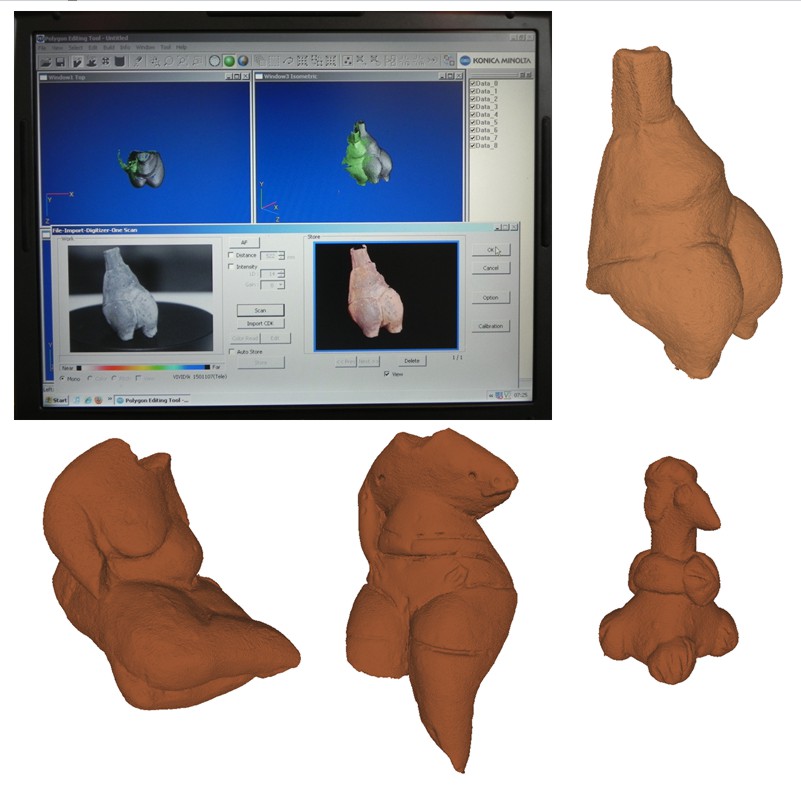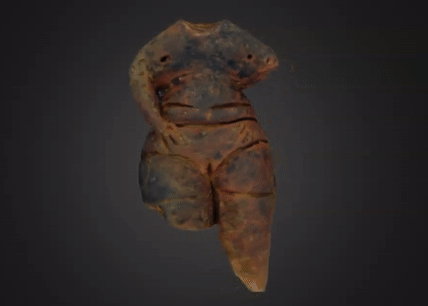Apart from capturing objects’ colour and texture, there are more advanced techniques which enable the recording of objects’ form. These will all be covered in the following lessons and units:
 |
|
3D models of figurines from Koutroulou Magoula, Greece constructed by the Konica Minolta Vivid 9i non-contact 3D digitised. (Click to Enlarge)
|
1) Non-contact 3D digitisers (see lesson 2.3), known as laser scanners, are devices that capture three-dimensional information of given surfaces, objects and structures, collecting points at a high rate and producing results in real time (Böhler and Marbs, 2002). Laser scanners generally operate on one of three principles: triangulation, time of flight and phase comparison, and generate a ‘point cloud’, which is a collection of three-dimensional (XYZ) co-ordinates that portrays to the viewer an understanding of the spatial distribution of a subject. Post-processing, which is sometimes quite time consuming, is needed to turn the point cloud into useful information, most often as a meshed model (Jones 2007, p. 12). Depending on the quality of the device used and the amount of post-processing, the results can range from accurate to extremely accurate, mainly regarding the acquisition of measurements and the morphology of the scanned objects. For example, the density of the point cloud highly depends both on the amount of scans of the subject-matter, as well as the time spent to register the results with the highest possible accuracy. The replication of texture and colour also depends on several factors, such as the detail that the device can capture, the number of scans obtained, as well as the amount of post-processing.
 |
|
Photogrammetric model of a Neolithic figurine from Koutroulou Magoula, Greece. (Click to Enlarge)
|
2) Photogrammetry (see lesson 3.4) is a technique that relies on photographs, and is used for deriving accurate three dimensional measurements. The simplest application of photogrammetry is to determine the distance between two points that lie on a plane parallel to the photographic image plane by measuring their distance on the image, if the scale of the image is known. More advanced applications of photogrammetry, called stereophotogrammetry (analogue, analytical or digital), involve the estimation of the three-dimensional coordinates of points on an object, which are determined by measurements made in a series of overlapping photographs taken from different positions. The XYZ coordinates of a given point on an object or surface are measured by the method of triangulation, according to which, rays are constructed from the camera location to the point on the object, and where these rays meet the 3D location of the point is determined. In recent years several applications have been developed which link the accuracy of photogrammetry with the detail of object recognition and modelling that computer vision produces (Hartley and Mundy 1993; see lessons in Unit IV). These methods produce three-dimensional photorealistic models which correspond to the properties of the real objects, and can also be used to derive accurate measurements (Pollefeys and VanGool 2002; Remondino and El-Hakim 2006).
References
- Böhler, W. and Marbs, A. (2002). 3D Scanning Instruments, In Proceedings of CIPA WG6 Scanning for Cultural Heritage Recording. Institute for Spatial Information and Surveying Technology. Germany: University of Applied Sciences. https://goobi.tib.eu/viewer/image/830281592/12/
- Jones, D. (2007). 3D Laser Scanning for Heritage. United Kingdom: English Heritage Publishing. https://historicengland.org.uk/images-books/publications/3d-laser-scanning-heritage/.
- Hartley, R. I., & Mundy, J. L. (1993). Relationship between photogrammmetry and computer vision. In Integrating photogrammetric techniques with scene analysis and machine vision (Vol. 1944, pp. 92-105). International Society for Optics and Photonics. http://users.cecs.anu.edu.au/~hartley/Papers/SPIE-93/joint-paper/joint2.pdf
- Pollefeys, M. and VanGool, L. (2002). From Images to 3D Models, Communications of the ACM 45(7), 50-55. https://doi.org/ 10.1145/514236.514263
- Remondino, F. and El-Hakim, S. 2006. Image-based 3D Modelling: A Review. The Photogrammetric Record 21(115), 269-291. https://doi.org/10.1111/j.1477-9730.2006.00383.x




